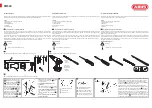
3-10
OPERATION
HT4100 Instruction Manual: Operation
require manual control by the operator. Select the arc current, arc voltage and pierce
delay time from the
Cut Chart
on pages 3-12 for the type and thickness of metal to be
cut.
12. Set the switch (S2) on the gas console to Test Preflow. Test preflow uses a nitrogen
and oxygen mixture as the preflow gas. The plasma and shield preflow rates are set on
the PLASMA (FM1 and FM3) and SHIELD (FM2 and FM4) flowmeters using the
PLASMA (MV1 and MV4) and SHIELD (MV3 and MV6) metering valves and are speci-
fied in the
Cut Chart
on page 3-12.
13. Set the switch to Test Cut Flow. This position allows the plasma and shield test cut flow
rates to be set on the PLASMA O
2
flowmeter (FM1) using PLASMA Cut Flow switch
(S3) and on the SHIELD O
2
and N
2
flowmeters using the SHIELD Cut Flow metering
valves (MV2 and MV5). Test cut flow rates are specified in the
Cut Chart
on page 3-12.
14. Set switch (S2) to Run after the test preflow and test cut flow rates have been set.
15. The system is now ready for operation.
COMMON CUTTING FAULTS
•
Torch pilot arc will initiate, but will not transfer. Cause can be:
1.
Work cable connection on cutting table not making good contact.
2.
Malfunction in HT4100 system. See HT4100 Instruction Manual: Maintenance (#801670).
3.
The torch initial height is set too high.
•
The workpiece is not totally penetrated, and there is excessive sparking on top of the workpiece.
Causes can be:
1.
Current is set too low (check
Cut Chart
information).
2.
Cut speed is too high (check
Cut Chart
information).
3.
Torch parts are worn (see
Changing Consumable Parts
).
4.
Metal being cut is too thick.
•
Dross forms on the bottom of the cut. Causes can be:
1.
Cutting speed is too slow or too fast (check
Cut Chart
information).
2.
Arc current set too low (check
Cut Chart
information).
3.
Torch parts are worn (see
Changing Consumable Parts
).
6-96













































